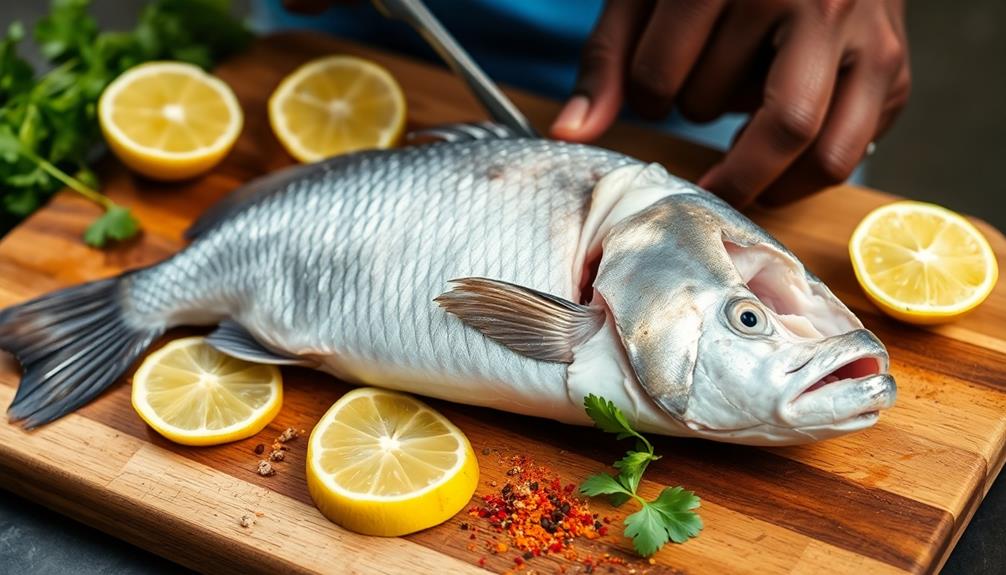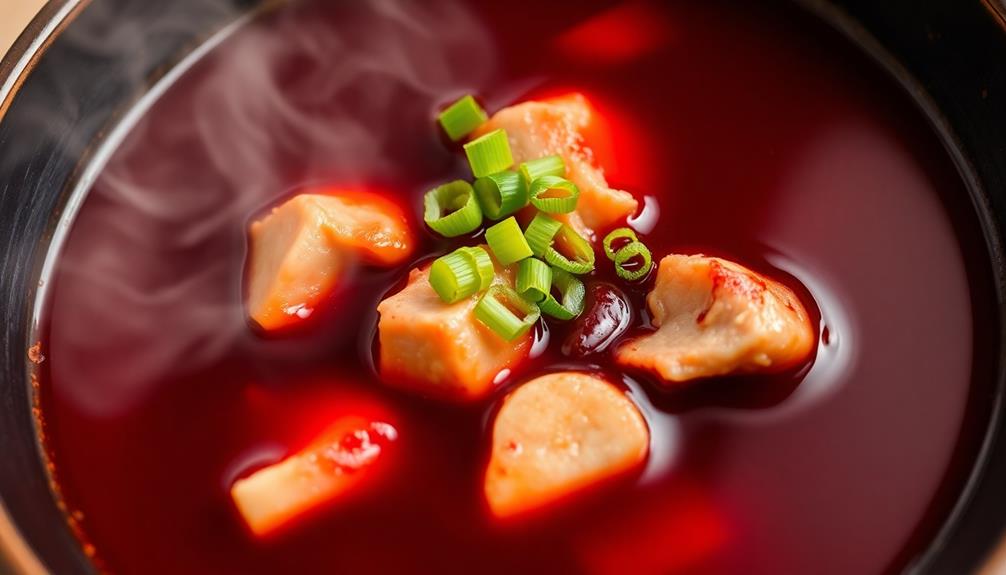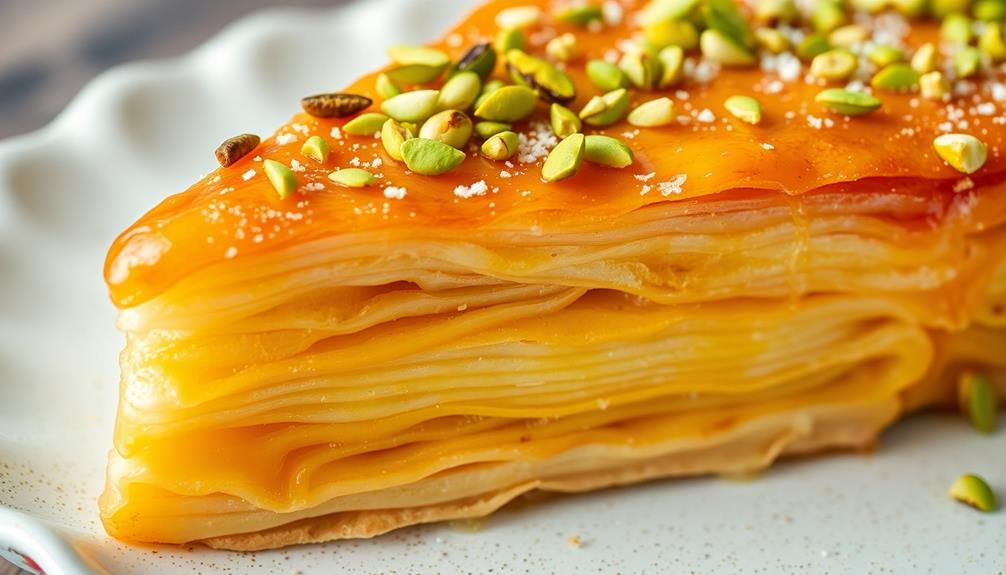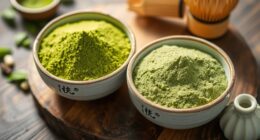Chambo, the beloved fish of Malawi, has captivated locals for centuries with its delicate, buttery flavor. This freshwater fish from the vast Lake Malawi is a cultural treasure, featuring in traditional recipes passed down through generations. Whether grilled, fried, or simmered in stews, chambo pairs perfectly with the staple maize porridge known as nsima. Not only is chambo delicious, but it's also packed with healthy omega-3s. Chambo fishing supports many Malawian families, and sustainable practices help protect this unique aquatic species. There's so much more to discover about this remarkable fish and Malawi's rich culinary heritage.
Key Takeaways
- Chambo is a type of fish native to Lake Malawi, central to the culinary heritage and economy of Malawi.
- Chambo holds significant cultural and traditional significance, featured in various community celebrations and meals.
- Chambo is a beloved staple in Malawian cuisine, commonly prepared through grilling, frying, or simmering in stews.
- Sustainable fishing practices are crucial for maintaining chambo populations and protecting the ecosystem of Lake Malawi.
- The chambo fishery sector contributes substantially to the local economy through trade, tourism, and livelihood support.
History
Historically, the Chambo fish has been a staple in the diets of Malawians for centuries. This tasty freshwater fish, native to the crystal-clear waters of Lake Malawi, has been an integral part of the country's rich culinary heritage.
For generations, Malawian families have cherished the Chambo, passing down traditional recipes and fishing techniques from one generation to the next. The origins of the Chambo can be traced back to the ancient civilizations that thrived along the shores of Lake Malawi.
These early inhabitants recognized the Chambo's exceptional flavor and nutritional value, and they developed sustainable fishing methods to ensure its abundance. Today, the Chambo remains a beloved centerpiece of Malawian cuisine, gracing the tables of households and restaurants alike.
Whether grilled, fried, or incorporated into hearty stews, the Chambo is a true taste of Malawi's rich culinary heritage. Its delicate texture and subtly sweet flavor have captivated the palates of locals and visitors alike, making it a must-try for anyone exploring the wonders of this enchanting African country.
Recipe
Chambo is a popular freshwater fish found in the Lake Malawi region of Africa. It's a staple food in the Malawian diet and is often prepared in a variety of ways, including grilling, frying, and braising.
The recipe below outlines a traditional method for cooking chambo, which involves simmering the fish in a flavorful sauce. This dish is typically served with nsima, a thick maize-based porridge that's a dietary staple in Malawi.
- 4 whole chambo fish, cleaned and scaled
- 1 onion, thinly sliced
- 2 tomatoes, diced
- 1 tablespoon tomato paste
- 1 teaspoon paprika
- 1 teaspoon ground cumin
- 1 teaspoon salt
- 1/4 cup water
In a large skillet, heat a small amount of oil over medium heat. Add the sliced onion and sauté until translucent, about 5 minutes.
Add the diced tomatoes, tomato paste, paprika, cumin, and salt. Stir to combine and let the mixture simmer for 10 minutes, stirring occasionally.
Carefully add the whole chambo fish to the skillet, and pour in the water. Bring the mixture to a gentle simmer, then cover and cook for 20-25 minutes, or until the fish is cooked through and flakes easily with a fork.
Serve the chambo warm, accompanied by nsima or other traditional Malawian side dishes.
When cooking chambo, it's important to handle the fish gently to prevent it from falling apart. Additionally, the cooking time may vary depending on the size of the fish, so it's best to check for doneness regularly.
Enjoy this traditional Malawian dish and savor the flavors of Lake Malawi.
Cooking Steps
Soak your Chambo fish overnight to tenderize it.
Then, rinse the fish thoroughly to remove any dirt or debris.
Next, fry the fish in hot oil until it's golden brown.
Drain the fish and pat it dry before serving it hot – your family's going to love this delicious Malawian dish!
Step 1. Soak Chambo Fish Overnight

Soaking the Chambo fish overnight is a crucial step in preparing this traditional Malawian dish. You'll need to plan ahead, as the fish needs to sit in water for at least 8 hours before cooking. This helps remove any muddy or earthy flavors, leaving you with a deliciously fresh, tender fish.
Start by placing the whole Chambo fish in a large bowl or container. Cover the fish completely with cool, clean water. Pop a lid on top and let it sit overnight in the fridge.
In the morning, you'll notice the water has turned a slightly murky color – that's all the impurities being drawn out of the fish. Drain the water and give the Chambo a gentle rinse. Now it's ready for the next steps in the cooking process.
Soaking the Chambo is an important technique that helps bring out the best flavors. With just a little preparation the night before, you're on your way to a delicious traditional Malawian feast!
Step 2. Rinse Fish Thoroughly
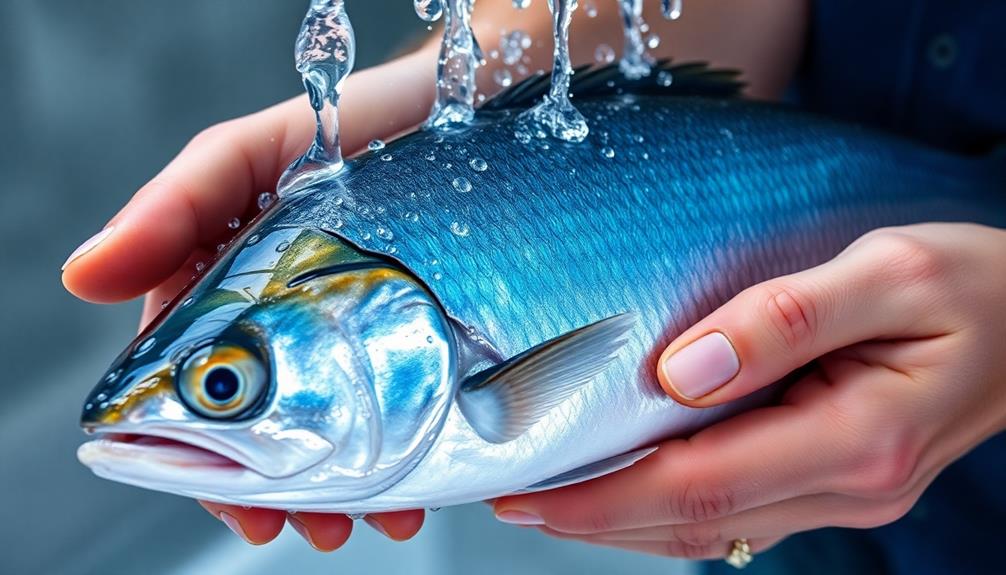
After soaking the Chambo fish overnight, be sure to give it a thorough rinse under cool running water. This will wash away any lingering dirt, debris, or fishy odors that may have built up.
Gently rub the skin with your fingers to dislodge any stubborn specks, then let the water flow over the fish to carry it all away. You'll know it's clean when the water runs clear instead of murky.
Don't be afraid to really get in there and scrub – you want this fish sparkling fresh! Rinsing is a crucial step to ensure your Chambo turns out delicious.
Once it's all cleaned up, pat the fish dry with paper towels and you're ready for the next part of the recipe. Get excited, because you're well on your way to a mouthwatering Chambo dish!
Step 3. Fry Fish in Hot Oil
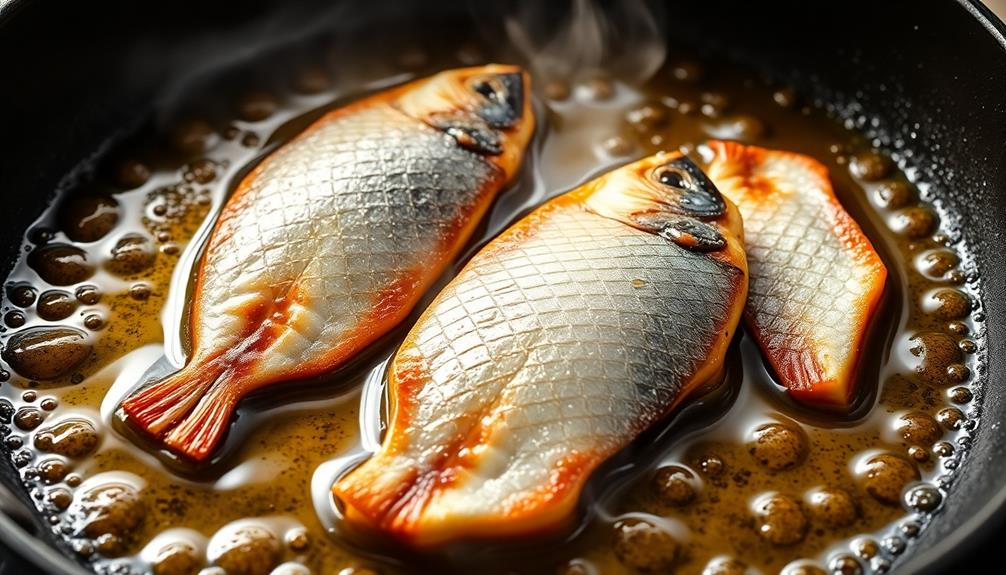
Next, you'll want to heat up a generous amount of oil in a large skillet or frying pan over medium-high heat.
Once the oil is sizzling hot, it's time to carefully add your rinsed Chambo fish. Gently lower each fillet into the oil, making sure not to overcrowd the pan. The fish should sizzle and dance as it hits the hot oil, filling the air with a mouthwatering aroma.
Let the Chambo fry for 3-4 minutes per side, or until the outside is golden brown and crispy. Use a spatula to flip the fillets, being extra careful not to break them apart.
As the fish cooks, you'll notice the flesh turning opaque and flaky – a telltale sign that it's ready. Once both sides are perfectly fried, transfer the Chambo to a paper towel-lined plate to drain off any excess oil.
Get ready to enjoy the delicious, crunchy exterior and tender, flavorful interior of your homemade Malawian Chambo!
Step 4. Drain and Pat Fish Dry
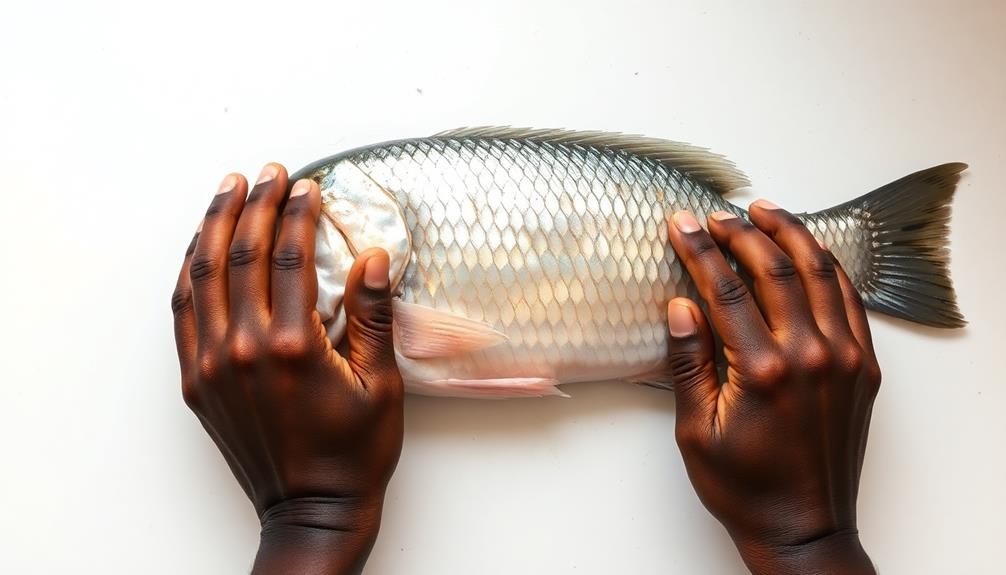
Once you've finished frying the Chambo fish, it's important to drain and pat it dry.
Carefully transfer the sizzling hot fish from the oil using a slotted spoon or tongs. Let the excess oil drip off, then place the fish on a clean paper towel-lined plate or baking sheet.
Gently press down on the fish with more paper towels to soak up any remaining oil. This step helps to create a nice, crispy texture on the outside of the fish when you finally serve it up.
Don't skip this part – you want your Chambo to be perfectly dry and ready to enjoy. With the oil drained away, the rich, flaky meat inside will shine.
Now that your fish is prepped, you can start plating and garnishing it however you like. Get ready for some seriously delicious Chambo!
Step 5. Serve Chambo Fish Hot
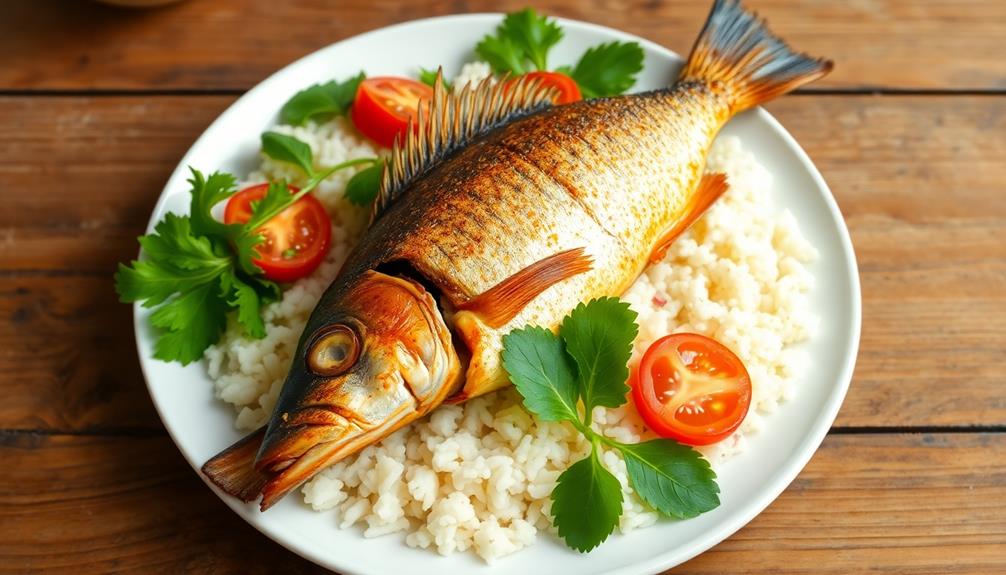
With the Chambo fish nicely drained and blotted dry, it's time to serve it up hot!
First, gather your plates and get them nice and warm. You can do this by popping them in the oven for a few minutes. This will help keep your delicious Chambo fish toasty as you bring it to the table.
Now, carefully transfer the fish fillets onto the warm plates. Mmm, just look at that flaky, tender meat! It's begging to be devoured.
Don't be shy – go ahead and take a big whiff. Can you smell the mouthwatering aroma? That's the sign of a meal that's about to hit the spot.
Final Thoughts
Contemplating the essence of chambo, one can't help but marvel at the intricate culinary heritage that has been carefully preserved and passed down through generations in Malawi. . This dish showcases the rich flavors of Malawian cuisine and exemplifies the importance of food in their cultural identity. Similarly, chambo holds a similar significance in Ugandan cuisine, as it is considered a Ugandan cuisine staple and is prepared in a variety of ways to showcase the diverse and vibrant flavors of the region.
From the moment the fresh, succulent fish is plucked from the sparkling waters, to the sizzling sound it makes as it hits the hot pan, every step in the preparation of this beloved dish carries the weight of history and tradition.
The rich, buttery flavor and delicate texture of the chambo captivate the senses, transporting you to the heart of Malawian culture with each delightful bite.
Whether served piping hot, accompanied by the fluffy staple of nsima, or enjoyed in a simple salad, this versatile fish has the power to unite communities and evoke cherished memories.
As you savor the essence of chambo, you'll find yourself longing to return to this vibrant corner of Africa, where the rhythms of life are intertwined with the rhythms of the lake.
Frequently Asked Questions
What Type of Fish Is Chambo?
Chambo is a type of freshwater fish. It's a popular food fish found in African lakes and rivers, known for its delicate flavor and firm texture. You'll often find it served grilled, fried, or in stews.
Where Can I Find Chambo in Malawi?
You can find chambo, a type of tilapia fish, in the major lakes and rivers of Malawi, such as Lake Malawi, Lake Chilwa, and the Shire River. It's a popular and widely available freshwater fish in the country.
How Much Does Chambo Typically Cost?
The cost of chambo can vary depending on the region, market, and time of year. On average, you can expect to pay between 1,000 and 3,000 Malawian Kwacha per kilogram for this freshwater fish.
Is Chambo a Popular Dish in Malawi?
Is chambo a popular dish? It sure is! Folks in Malawi can't get enough of this delectable fish. It's a staple on menus across the country, from small local eateries to high-end restaurants. Chambo's popularity is undeniable.
What Are the Health Benefits of Eating Chambo?
Eating this nutritious fish provides several health benefits. It's packed with lean protein, essential omega-3 fatty acids, and vital vitamins and minerals that can boost your heart health, brain function, and overall wellbeing. Incorporating it into your diet is a tasty way to support your wellness.
